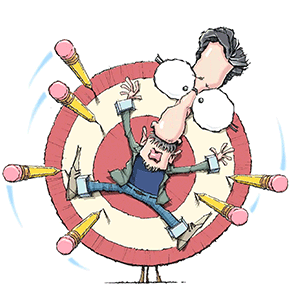Wall Street got the rally signals from Powell it was hoping for
Published in News & Features
For much of this month, Wall Street traders piled into stocks and bonds, betting that the Federal Reserve was finally ready to start cutting interest rates again. All they were waiting on was the green light from Jerome Powell to keep the rally going.
They got exactly what they were looking for on Friday, when the Fed Chair unleashed the biggest cross-markets surge since April by striking a dovish tone during the highly anticipated speech.
Treasuries rallied, driving two-year yields down as much as 12 basis points, and futures traders started made bets that a September rate cut is very likely after Powell said the “shifting balance of risks may warrant adjusting our policy stance.”
The S&P 500 Index rebounded from a five-day slide, rising 1.5% and closing just shy of a record high. Meanwhile, the Russell 2000 surged almost 4% on the back of rate- and economically-sensitive stocks. The dollar slid and risk assets like Bitcoin gained, anticipating the central bank will use policy to spur growth. Gold rose 1%.
“This is an important shift for Chairman Powell,” said Matt Maley, chief market strategist at Miller Tabak + Co LLC. “The question for the markets now is whether concerns over slower growth will cause earnings to decline, but the Fed is not going to create significant headwinds for investors.”
Powell’s speech at the annual Jackson Hole, Wyoming, symposium was eagerly awaited by financial markets, which early this month started pricing in near certainty that the Fed would cut interest rates by a quarter percentage point at next month’s meeting, the first reduction since December. With the job market losing steam, some options traders even bet on a half-point move — the sort of cut typically reserved for emergencies.
The speculation fanned risk sentiment across markets, propelling stocks to new record highs through late last week, despite concerns that President Donald Trump’s trade war is slowing the economy and worries that the Big Tech stocks driving the gains have run up too far. By April 14, the S&P 500 had rallied 30% off its early-April lows, when Trump’s tariff rollout briefly sent markets into a tailspin, largely due to the torrid advance of companies like Nvidia Corp. that are profiting from a surge of spending on artificial intelligence.
But over the last several days, doubts about the Fed’s next move started seeping in and some central bank officials warned a September cut wasn’t certain. The rally stalled after the government reported that wholesale inflation in July jumped by the most in three years, reigniting fears that stagflation could limit the central bank’s room to cut rates. That pulled the S&P 500 down for the five-straight days through Thursday and pushed up Treasury yields.
That reversed after Powell signaled that the Fed is prepared to change course, echoing what happened a year ago at the Jackson Hole event, when he telegraphed that the central bank was poised to start pulling rates back from a more than two-decade high.
Later on Friday, Fitch Ratings affirmed the US credit grade at AA+ with a stable outlook. The move didn’t shift the markets, but it may have helped to justify traders’ optimism.
The Fed has remained on hold in 2025 as Trump’s policy shifts amplified the uncertainty in the economic outlook, leaving Powell trying to balance the risk of reaccelerating inflation against a slowdown in growth.
While the employment figures earlier this month showed that the job market was weaker than had been expected, other indicators point to some economic strengths and corporate earnings have continued to bolster the stock market’s optimism.
The central bank is also facing unprecedented pressure from Trump, who has jettisoned the traditional respect for the Fed’s autonomy by attacking Powell for not cutting rates and threatening to fire a Fed governor over allegations of mortgage fraud. In the face of that, Powell has seemed eager to assure markets that the Fed won’t allow politics to dictate monetary policy.
The Fed is “under a white hot political spotlight right now,” said Tony Rodriguez, head of fixed-income strategy at Nuveen Asset Management. “This maybe helped to lower the temperature just a bit.”
Still, the president seemed unimpressed by Powell’s speech on Friday, telling reporters that the Fed should have lowered rates a year ago.
“We call him ‘Too Late’ for a reason,” Trump said.
The markets have been caught offsides by prematurely anticipating a Fed pivot several times since the pandemic, and Powell has consistently underscored that the bank is taking a data-dependent approach, making it still difficult to predict how deeply the central bank will cut over the next several months.
Dan Carter, portfolio manager at Fort Washington Investment Advisors, said that even with Powell’s more dovish tone, the data in coming weeks still pose some risks.
“The market will like this change in tone,” he said. “But I think we have to be careful not to get too far ahead. There is still a lot of data between now and the next FOMC meeting.”
(With assistance from Michael MacKenzie, Emily Graffeo and Carter Johnson.)
©2025 Bloomberg L.P. Visit bloomberg.com. Distributed by Tribune Content Agency, LLC.







Comments